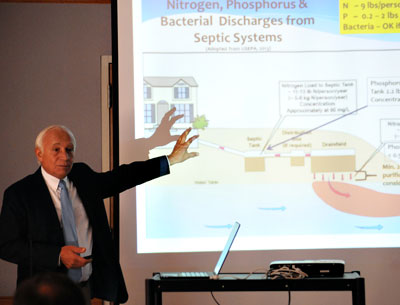Wastewater Is Put Under a Microscope

Upgrades to septic systems or neighborhood wastewater systems are warranted to address problems on a number of properties in East Hampton Town where improper treatment of sewage is contributing to ground or surface water pollution, a town wastewater consultant said Tuesday. Pio Lombardo of Lombardo Associates, who authored a draft town wastewater management plan, said during a presentation on Tuesday that the consultants assessed all of the 20,058 developed lots in the town, using information about their size, location, soils, date of construction, and more to make conclusions about the state of each property’s wastewater system and its potential contribution to environmental pollution. Of those 20,058, Mr. Lombardo said, he took a closer look at about 7,500, including those in various watersheds. So far, the review has identified problems that should be corrected on at least 1,760 properties. Bacterial contamination due to the proximity of wastewater and private well water systems was identified on 960 properties and needs correction, Mr. Lombardo said. In addition, neighborhood treatment systems have been suggested to solve various wastewater issues on the 656 properties in the East Hampton Village business district and in Montauk’s Ditch Plain, Camp Hero, downtown, and dock areas. Further study of the Hook Pond, Georgica Pond, and Fort Pond watersheds is needed before determinations may be made about the need for action on the 3,545 properties in those areas, Mr. Lombardo said yesterday. The manner in which individual property owners will be notified of the conclusions about their wastewater systems has yet to be decided. What could be required of property owners — and how the work would be done and paid for — will be a matter of town policy, Mr. Lombardo said. He recommended first that the town enforce an existing requirement for periodic inspection of wastewater systems. At the least, Mr. Lombardo said, inspections should be required when a property changes hands. “We’re suggesting, at a minimum, the ones that need to be upgraded are the ones that are causing contamination to groundwater.” In such cases of bacterial contamination, he said, fixes to a private septic system could likely be accomplished for $10,000 to $15,000. The cost of more extensive system upgrades to address nitrogen and phosphorous releases, which could be needed particularly in watershed areas, could be up to $40,000, Mr. Lombardo said. “In general, the capacity of East Hampton watersheds to process human impacts without severe adverse impacts has been exceeded due to nitrogen, phosphorous, and bacterial contamination,” the consultant said. But overall, the conditions in the town as far as wastewater and pollution are not bad, by comparison to other areas, he said. Addressing the “equity issue” about who shoulders the cost for work that will benefit the community as a whole by safeguarding clean water will be a “community decision,” Mr. Lombardo said. There are a range of scenarios, he said, from having individual property owners pay for required work to having the town contribute a percentage or pay the full cost. Mr. Lombardo said he advises against communities relying on federal or state help or grants to cover the costs of water quality protection projects. But, he said, various funding strategies could be explored, including pursuing a revision to the Peconic Bay Region Community Preservation Fund law that would allow a portion of the revenue from a 2-percent real estate transfer tax to be used for water quality and wastewater management projects. The consultant’s full report is posted online at ehwaterrestore.com. A number of properties have several potential problems related to wastewater systems, such as legal issues or impermeable soils. A table in the consultant’s report summarizing “Wastewater Needs by Sub Study Area” breaks them down by type of problem, and its total of 4,326 properties with “wastewater needs” does not reflect the number of individual sites in the town that need wastewater system upgrades, as some sites are included in several categories. Issues and recommendations about specific areas will be addressed by the consultant at numerous upcoming meetings with the town board and various community groups. The next related town board discussion and presentation will take place on Oct. 14 at 10 a.m. at the Montauk Firehouse, and focus on wastewater issues in Montauk. The consultant recommended establishing a townwide comprehensive wastewater management plan advisory committee and subcommittees to focus on specific neighborhoods to work with him and with town officials on developing a plan for how to implement needed changes. It should address legal and financial issues, he said. Projects should be prioritized, he said. Further study of watershed areas could take a year or two, said Mr. Lombardo, as could establishing and testing model projects using underground “permeable reactive barriers” that could be used to filter pollutants away from surface waters. The installation of neighborhood wastewater treatment systems could be accomplished within five years from a decision to move forward with them, he said.
